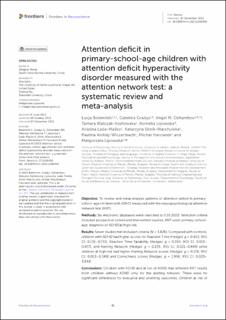| dc.contributor.author | Bieleninik, Lucja | |
| dc.contributor.author | Gradys, Gabriela | |
| dc.contributor.author | Dzhambov, Angel M. | |
| dc.contributor.author | Walczak-Kozłowska, Tamara | |
| dc.contributor.author | Lipowska, Kornelia | |
| dc.contributor.author | Lada-Masko, Ariadna | |
| dc.contributor.author | Sitnik-Warchulska, Katarzyna | |
| dc.contributor.author | Anikiej-Wiczenbach, Paulina | |
| dc.contributor.author | Harciarek, Michał | |
| dc.contributor.author | Lipowska, Małgorzata | |
| dc.date.accessioned | 2023-12-20T10:48:07Z | |
| dc.date.available | 2023-12-20T10:48:07Z | |
| dc.date.created | 2023-12-11T11:02:20Z | |
| dc.date.issued | 2023 | |
| dc.identifier.citation | Frontiers in Neuroscience. 2023, 17 . | en_US |
| dc.identifier.issn | 1662-4548 | |
| dc.identifier.uri | https://hdl.handle.net/11250/3108366 | |
| dc.description.abstract | Objective: To review and meta-analyze patterns of attention deficit in primary-school-age children with ADHD measured with the neuropsychological attention network test (ANT). Methods: Six electronic databases were searched to 5.05.2022. Selection criteria included prospective cohort and intervention studies; ANT used; primary-school-age; diagnosis of ADHD/at high risk. Results: Seven studies met inclusion criteria (N = 3,826). Compared with controls, children with ADHD had higher scores for Reaction Time (Hedges’ g = 0.433; 95% CI: 0.135–0.731), Reaction Time Variability (Hedges’ g = 0.334; 95% CI: 0.012–0.657), and Alerting Network (Hedges’ g = 0.235; 95% CI: 0.021–0.449) while children at high risk had higher Alerting Network scores (Hedges’ g = 0.176; 95% CI: 0.003–0.349) and Correctness scores (Hedges’ g = 1.956; 95% CI: 0.020–3.892). Conclusions: Children with ADHD and at risk of ADHD had different ANT results from children without ADHD only for the alerting network. There were no significant differences for executive and orienting outcomes. Children at risk of ADHD also made more errors (commission and omission) measured with the ANT compared with children without ADHD. Reaction time was longer and reaction time variability higher in children with ADHD than in children without ADHD, and in children at risk of ADHD compared with children without ADHD. | en_US |
| dc.language.iso | eng | en_US |
| dc.rights | Navngivelse 4.0 Internasjonal | * |
| dc.rights.uri | http://creativecommons.org/licenses/by/4.0/deed.no | * |
| dc.title | Attention deficit in primary-school-age children with attention deficit hyperactivity disorder measured with the attention network test: a systematic review and meta-analysis | en_US |
| dc.title.alternative | Attention deficit in primary-school-age children with attention deficit hyperactivity disorder measured with the attention network test: a systematic review and meta-analysis | en_US |
| dc.type | Peer reviewed | en_US |
| dc.type | Journal article | en_US |
| dc.rights.holder | © 2023 Bieleninik, Gradys, Dzhambov, Walczak-Kozłowska, Lipowska, Łada-Ma´sko, Sitnik-Warchulska, Anikiej-Wiczenbach, Harciarek and Lipowska | en_US |
| dc.description.version | publishedVersion | en_US |
| cristin.ispublished | true | |
| cristin.fulltext | original | |
| cristin.qualitycode | 1 | |
| dc.identifier.doi | 10.3389/fnins.2023.1246490 | |
| dc.identifier.cristin | 2211634 | |
| dc.source.journal | Frontiers in Neuroscience | en_US |
| dc.source.volume | 17 | en_US |
| dc.source.pagenumber | 28 | en_US |

